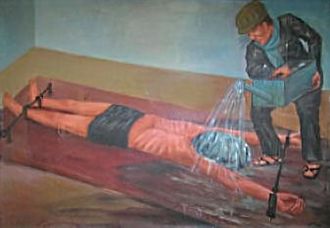A Halloween Horror Story: Waterboarding
Some top American politicians actually endorsed the use of the fearful torture technique known as waterboarding during the dark early days of the “War on Terror”
Waterboarding is a form of water torture in which water is poured over a cloth covering the face and breathing passages of an immobilized captive, causing the individual to experience the sensation of drowning. Waterboarding can cause extreme pain, dry drowning, damage to lungs, brain damage from oxygen deprivation, other physical injuries including broken bones due to struggling against restraints, lasting psychological damage, and death. Adverse physical consequences can manifest themselves months after the event, while psychological effects can last for years.
In the most common method of waterboarding, the captive’s face is covered with cloth or some other thin material, and the subject is immobilized on his/her back at an incline of 10 to 20 degrees. Torturers pour water onto the face over the breathing passages, causing an almost immediate gag reflex and creating a drowning sensation for the captive. Vomitus travels up the esophagus, which may then be inhaled. Victims of waterboarding are at extreme risk of sudden death due to the aspiration of vomitus.
The term water board torture appeared in press reports as early as 1976. In late 2007, it was widely reported that the United States Central Intelligence Agency (CIA) was using waterboarding on extrajudicial prisoners and that the Office of Legal Counsel, Department of Justice, had authorized the procedure among enhanced interrogation techniques. Senator John McCain noted that the United States military hanged Japanese soldiers for waterboarding American prisoners of war during World War II. The CIA confirmed having used waterboarding on three Al-Qaeda suspects in 2002 and 2003.
In August 2002 and March 2003, in its war on terror, the George W. Bush administration issued what became known as the Torture Memos after being leaked in 2004. These legal opinions argued for a narrow definition of torture under US law. The first three were addressed to the CIA, which took them as authority to use the described enhanced interrogation techniques (more generally classified as torture) on detainees classified as enemy combatants.







